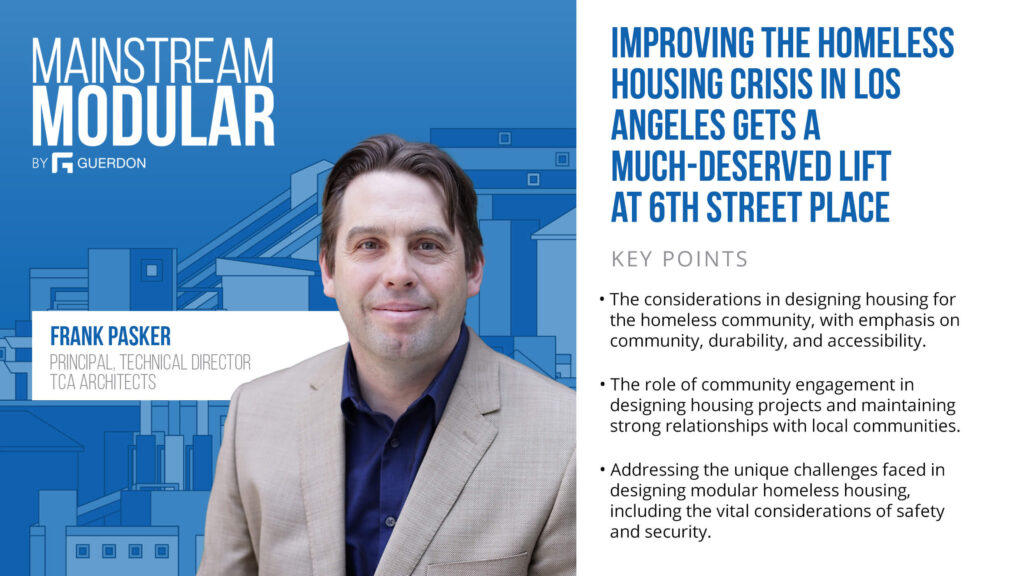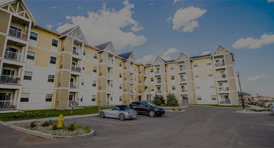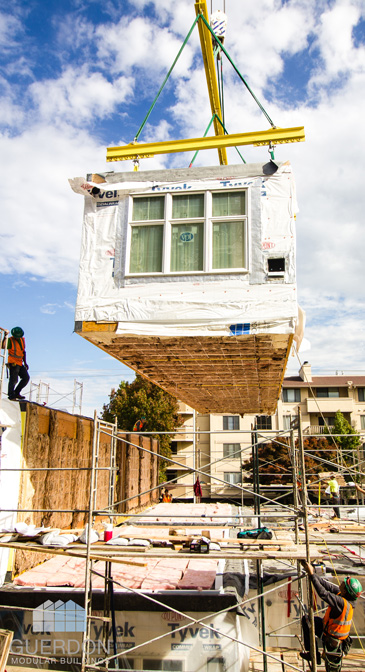
JUNE 28, 2023 – Amid the homeless housing crisis in Los Angeles, a glimmer of hope appears in the form of modular housing projects designed to provide much-needed shelters for the homeless community. LA is home to over 40,000 homeless individuals, a number that’s seen a sharp increase of 16% over the past year. Yet, innovative design principles and strategies are making a tangible impact on this pressing issue, offering a timely and increasingly successful solution to homelessness.
What, then, are the design principles and strategies contributing to the success of these modular housing projects? And how might these principles inform similar projects in the future?
Welcome to Mainstream Modular by Guerdon, a podcast that dives into the heart of modular housing’s potential to address homelessness. Host Gabrielle Bejarano brought on Frank Pasker, Principal and Technical Director of the LA Division at TCA Architects, to discuss the success story of a homeless housing project at 6th Street Place in Los Angeles. They discussed the design principles behind this and other successful projects, providing insights into how architects tackle homelessness with innovative and empathetic design.
In this episode, Gabrielle and Frank explore:
The considerations in designing housing for the homeless community, with emphasis on community, durability, and accessibility
The role of community engagement in designing housing projects and maintaining strong relationships with local communities
Addressing the unique challenges faced in designing modular homeless housing, including the vital considerations of safety and security
Frank Pasker is a seasoned architect who has spent his career in Los Angeles since 2001, focusing on affordable housing projects. His work spans various projects, from affordable to market-rate high-rise buildings. His dedication and proficiency in his field have made him a leading figure in addressing the housing crisis, particularly in homeless housing. With multiple projects under his belt, Pasker brings a wealth of knowledge and experience, making him a leading voice in this pivotal conversation on homelessness and housing design.
 Mainstream Modular Spotify Podcast
Mainstream Modular Spotify Podcast  Mainstream Modular Apple Podcast
Mainstream Modular Apple Podcast
The Nuances of Designing Housing For The Homeless Community
Transcript:
Gabrielle: Hello everyone and welcome to a podcast brought to you by Mainstream Modular. I’ll be your host for today, Gabrielle, and I am thrilled to be joined right now by none other than Frank Pasker, who’s Principal as well as Technical Director of the LA Division at TCA Architects. And today we’re going to be talking about a great example of a successful homeless housing project in 6th Street Place. So today we’re going to dig into that as well as some other projects that Frank has worked on to kind of see the common denominator on what the successful design principles were that contributed to the major success of these projects and others. So here to enlighten us on the subject as well as provide any and all industry insights is Frank. So Frank, welcome.
Frank: Thank you. Thanks for having me.
Gabrielle: Absolutely. So to start off, go ahead and give our audience just a brief bio on your background. So how did you start? What experience do you have in the industry? What led you to the 6th Street Place project?
Frank: Yeah, so I started my career here in Los Angeles in 2001, working for a small company in the West Side. And starting from then, I was already involved in doing affordable housing projects. As a matter of fact, at that office, I did two projects on the very same block that 6th Street Place is on right now. So I’ve covered three of the four corners of the block during my career. I mostly work on multifamily mixed-use projects. So not just affordable, also market rate, high-rise podium buildings, but the affordable housing sector has been really one of my main focuses. And we have been doing a lot of those projects at TCA since I started there.
Gabrielle: Well, thank you for sharing a little bit on your background. You clearly have an illustrious career and a lot of experience. So what have you found time and time again to be some of the key considerations when designing housing specifically for what we’re talking about for the homeless community?
Frank: Yeah, there’s some unique properties when it comes to affordable housing. It’s community, durability, and accessibility. Housing for homeless is creating a new community for people who’ve been living out in the street, a community they can feel safe in, and they can interact with people without threats or anything. Durability is for the maintenance cost of obviously owners of affordable housing projects are long-term holders, so they keep the projects for a long time. And therefore, we have to design with this aspect in mind. And the last of the three is basically the accessibility. Oftentimes when people come off the street, they do have disabilities. Oftentimes it’s where they got on the street in the first place. So we have to provide for those people special needs and accommodate that in the housing project.
Gabrielle: So those are just a few of the considerations out of many, but what are some of the solid strategies or design elements that are important for creating a sense of dignity and also empowerment for residents of homeless housing? So just what are some of the examples of those types of elements, but also ones you specifically infused into the 6th Street Place Project?
Frank: Yeah, basically once somebody gets off the street into housing, it’s really important for them to gain a foothold back into society. And the buildings have to provide areas where they can get a sense of space, a sense of home, a sense of privacy, and also access to services, professional training, and also quality recreation space. So on 6th Street, for example, we have several community spaces for different uses. We have a large community room for meetings and celebrations. We have smaller rooms for training and therapy sessions, and also multiple offices for support workers. And there’s also ample of open space in the courtyard that’s being overseen by the building’s corridors to provide protected outdoor activities and opportunities for the residents to gather. And there’s also common laundries in several floors of the building to further encourage communication.
Gabrielle: So we’ve talked considerations and strategies, but what role does community engagement play when designing homeless housing? How do you keep that in mind and ensure that the design meets the needs of both the residents, but also the surrounding community?
Frank: Yeah, that’s a very important factor for each of one of those projects. On the 6th Street Place, for example, the project was located at Ground Zero of the Homeless Crisis here in Los Angeles. It is replacing an old underutilized warehouse, and we’re putting a vibrant community there. The needs for the residents and the community are aligning here in this case, since both aim at re-engaging the homeless population as part of society, and also reintegrating them into civil life.
Gabrielle: Well, what collaborations or partnerships do you typically engage in when in the process of designing homeless housing? Collaboration and partnerships can be so very important to projects of these calibers. So who is on the team? Who do you need buy-in from? What does that team process look like?
Frank: Yeah. When you’re doing homeless housing, it’s actually a more involved process than regular market rate housing because of the extra layer of accessibility and the special services provided. Oftentimes the funding agencies dictating many of those, so communication with those agencies is very important, as well as early communication with the billing officials to make sure that the project moves quickly through the system. Sometimes cities have a very complicated process to get projects approved, and because we’re in the homeless crisis, we have to make sure to get those projects moved along the process as quickly as possible. And then oftentimes there’s also neighborhood outreach required to get buy-in from the current stakeholders in the community into the project.
Gabrielle: Well, there are plenty of project challenges just on its own. And putting together a project of this size or of this type, but more specifically, what are some of the potential challenges or obstacles faced with this project that we’re talking about now when you’re designing homeless housing and how do you come up with strategies to overcome them? And in terms of that, is security and safety one of those challenges? If so, how do you approach that issue when it comes to creating the design?
Frank: Absolutely. So security and safety are actually two of the most important aspects we have to address. In this case, we are located at the heart of the homeless community, Skid Row in Los Angeles, and the residents need to have a sense of home and safety, basically a place where they can leave their belongings, leave their stuff without being afraid that someone will take them or even harming them, which unfortunately happens oftentimes outside. But yet the design should not turn its back on the community outside. The goal is to create a place that has eyes on the street, to communicate with the street and to discourage unlawful activities. And the apartment units also need to provide a level of safety. So we did not have units on the ground floor and we also don’t have any climbable balconies near the ground floor.
Gabrielle: Well, there’s certainly a lot of considerations at play there. And I want to talk more about the specific design solution that was used on 6th Street Place. So what modular design solution was used in terms of, from an architect’s perspective, just the learning curve that was involved there and how modular specifically contributed to the success of this project?
Frank: Yeah, basically modular has like the unique property of working within a module and then using that module as a basis of design. So the main parameters is really finding out what those parameters are, the sizing, for example, that is regulated by transportation constraints. And then of course, the routing of utilities within the building. So the learning curve was very steep actually on the agency approval side because they were not really that versed in approving modular projects. So we got together with them, with the city and we talked about which agency approves what. As you know, the modules themselves have to go through state approval versus the overall building has to go through city approval. So we got together, we developed a matrix with the city basically so that each party knew which side they would inspect and look at and plan check so that we can streamline the whole approval process.
Gabrielle: Taking this whole conversation into account, what are some of the major key considerations that you want to kind of pinpoint and share with anyone considering designing their first modular homeless housing project?
Frank: Yeah, the designer needs to be aware of the dimensional parameters and how does modular units on those components go together because this is what ultimately drives the design process early on. And if somebody disregards that and just design something out of their mind without looking at those parameters, that can quickly lead to a cost increase in transportation or it even might be impossible to transport those modules and you’ve got to redesign the project.
Gabrielle: Well, in what ways can the design of homeless housing and the modular delivery method contribute to the larger goal of ending homelessness? This is a big question, but in what ways do you find that?
Frank:I think it has a major role once everybody is more used to the process because modular housing provides for one of the quickest field installations of housing units possible. And I don’t think that any other construction method can keep up with that. Like on 6th Street, the setting of the modules was just done in five weeks, that was it. So just imagine five weeks to put those units together and then afterwards you have to of course waterproof the envelope, connect all utilities, put up the roof and all those things. But I think the modular housing delivery process is the most efficient method to address the homeless crisis and to house people quickly and in dignity.
Gabrielle: Well, wrapping things up here, Frank, what is one unique or overlooked insight or even lesson you feel like you’ve gained from your experience in designing homeless housing that you think would be valuable for others in the field to know?
Frank: Yeah, during my career so far, I’ve been working over well over 2000 dwelling units and all kinds of markets. So market rate items, affordable houses and so on, different places, different types of construction. And in one way, homeless housing is no different than any other form of housing because it’s got to be the home for somebody. Somebody needs to identify with the place and they need to get a sense of place with the building and they got to be able to identify with it. I think that’s the most important thing. We don’t just create off the shelf housing and just put it there and put people in. It’s really something that they have to own and have the heart in. That’s why designers need to be aware of that. And they got to build a positive identity around each of the projects that will help foster the sense of home and also the sense of community. Like we always want to contribute with elements like an edible garden, a barbecue area for outdoor events, fire pit, where just people can sit around and talk and tell stories. Because those items are really needed to transform the people into kind of a more stable community, which I think is the most important aspect here in homeless housing.
Gabrielle: Well, that wraps up the conversation for today. So thank you to everyone who joined in on this episode and also to Frank for sharing some very valuable information regarding the 6th Place Project and how it came to be a success. So it was a pleasure to have you on the podcast.
Frank: Thanks for having me.
Gabrielle: Of course. And as always, for those listening in, if you’d like to learn more, please visit guerdonmodularbuildings.com and look for this podcast wherever it is you get your podcasts at. I’ve been your host, Gabrielle. Thanks for tuning in.
About Guerdon
Guerdon is the leading manufacturer of large-scale, commercial modular construction projects in the Western US and Canada. Guerdon’s modern, innovative modular technology combines on-site construction with precise off-site factory assembly line production. Traditional schedules are shortened substantially because modular units are constructed in our factory-controlled environment while site work and foundation construction are completed concurrently. Guerdon helps developers, architects and general contractors gain greater control over project quality, schedule, and the bottom line. Guerdon’s factory and corporate office are in Boise, Idaho serving 12 western states including California, Colorado, Idaho, Montana, Nevada, North Dakota, South Dakota, Oregon, Utah, Washington, Arizona and Wyoming as well as Canada.








